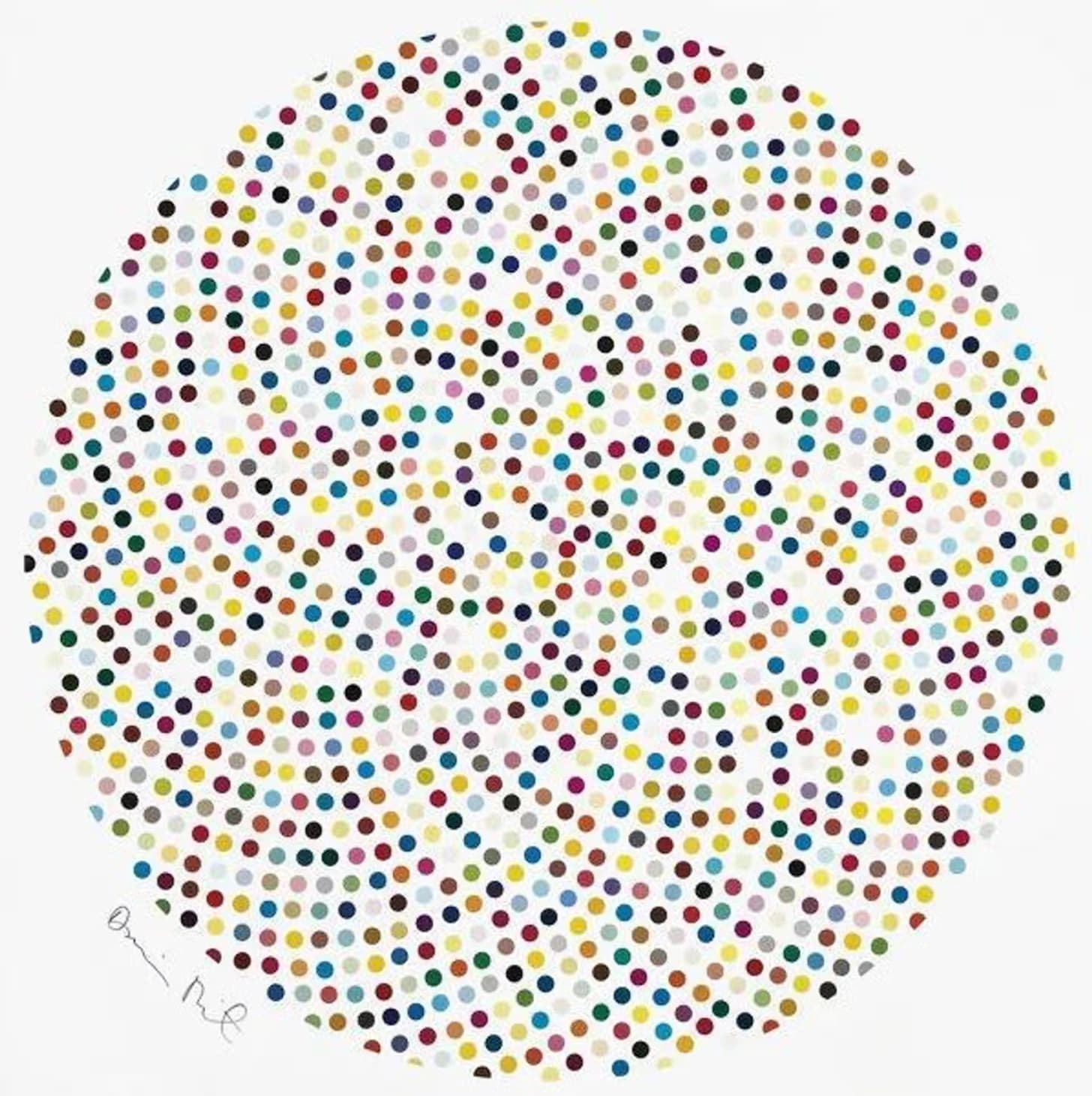This is Valium by Damien Hirst, one of the thousands of Spot Paintings he’s made and sold over the past four decades.
They’re much less controversial than his diamond skulls and preserved sharks, but still command a healthy price and generate plenty of comment on what the artist has created and its aesthetic value: the critics say his work is “redundant and oppressive”, “calming but addictive”, or “enthralling but monotonous”, depending on which one you listen to. If you decide to buy this Hirst print, you won’t have to worry about its authenticity, because he’s helpfully signed it right down there in the lower left to claim authorship. But there’s one important fact to know: Hirst doesn’t actually contribute a single brushstroke to any of these paintings, despite claiming they’re “his”.
Instead, the English artist-provocateur is following a long-standing tradition by using assistants to produce works he’s conceived and designed, but never touched. Raphael, Rubens, and Rodin all filled their workshops with students to boost capacity—and that’s just the Rs! This atelier system serves both to train young artists (da Vinci and Toulouse-Lautrec both learnt their trade in a master’s workshop) and to allow mature painters to crank out lots more innovative designs, farming out most or all of the actual brushwork to lesser lights. That’s why you’ll often see paintings attributed to “Workshop of Titian” or “Studio of Ingres”; the “name-brand” artist sketched out the arrangement of figures, specified the style and colours to use, then left his assistants to fill in the details. A particularly diligent master would do the tricky bits himself, like correcting small errors and filling in the faces and hands, but a less scrupulous one would let others handle everything, just signing his name to the completed work and taking the credit (and the payment!)
Now you can’t say “assistant” these days without sounding like you are talking about some form of “artificial intelligence”—and the analogy is surprisingly relevant even for the most Baroque of the ateliers. Each of your engineers is now surrounded by a swarm of helpful, super-fast bots like Copilot or Cursor that can crank out code faster than an eager student could paint a wizened tree for El Greco or a colourful spot for Hirst. At first blush, it might seem that this army of automated helpers will make programming trivial, that non-technical people can just vibe, chat, and drink a margarita while the machine writes all the code. But that’s no more true today than it was in 2001 when my first employer claimed their “Universal Application” would replace whole IT departments—it turned out those folks were in charge of useful, difficult things like scalability and security that couldn’t be delegated to a robot. As the Old Masters knew, a workshop needs the firm guidance of a deeply experienced master, especially when the workers therein are prone to confabulation and confusion.
Some folks do recognise the need for a hand on the tiller, but seem to think that the solution is to keep the bots in line by defining AI coding metrics or creating more complex automations. However, the answer to software slop isn’t more software. Instead, we should be learning from the bleeding-edge governance innovations of the first 16th-century ateliers. Raphael, for example, gave his assistants too much freedom at first when painting frescoes at the Vatican, leading to some “inexpressive, … ridiculous” work and “absurd figures”. He learnt from this mistake by the time he began his tapestries for the Sistine Chapel, where he made sure to execute a full set of preparatory drawings himself to better rein in his students. In later projects, he sometimes delegated certain routine planning steps, like making fair copies or drawing life studies, but kept tight control of composition, colour, and expression throughout production, “going over his assistants’ work until it looked in the end like his own entirely”. Throughout, Raphael’s improvements to his workshop methods were all organisational, not technological: he didn’t need sharper pencils, but a sharper process.
A CEO told me last week that he believes “two average developers plus AI tools can build an entire business.” He’s wrong on two fronts: you have to have master-level skill and experience to ensure you’re issuing the right instructions to your workshop of bots, and you need a thorough process of design, review, and testing to be sure the models are actually doing what your senior engineers tell them to. It’s not clear what this means for junior engineers—is there anything left for them to do?—but for goodness’ sake, don’t leave your workshop without a master by dumping your battle-scarred developers.
This first appeared in my weekly Insanely Profitable Tech Newsletter which is received as part of the Squirrel Squadron every Monday, and was originally posted on 24th March 2025. To get my provocative thoughts and tips direct to your inbox first, sign up here: https://squirrelsquadron.com/
.png)






